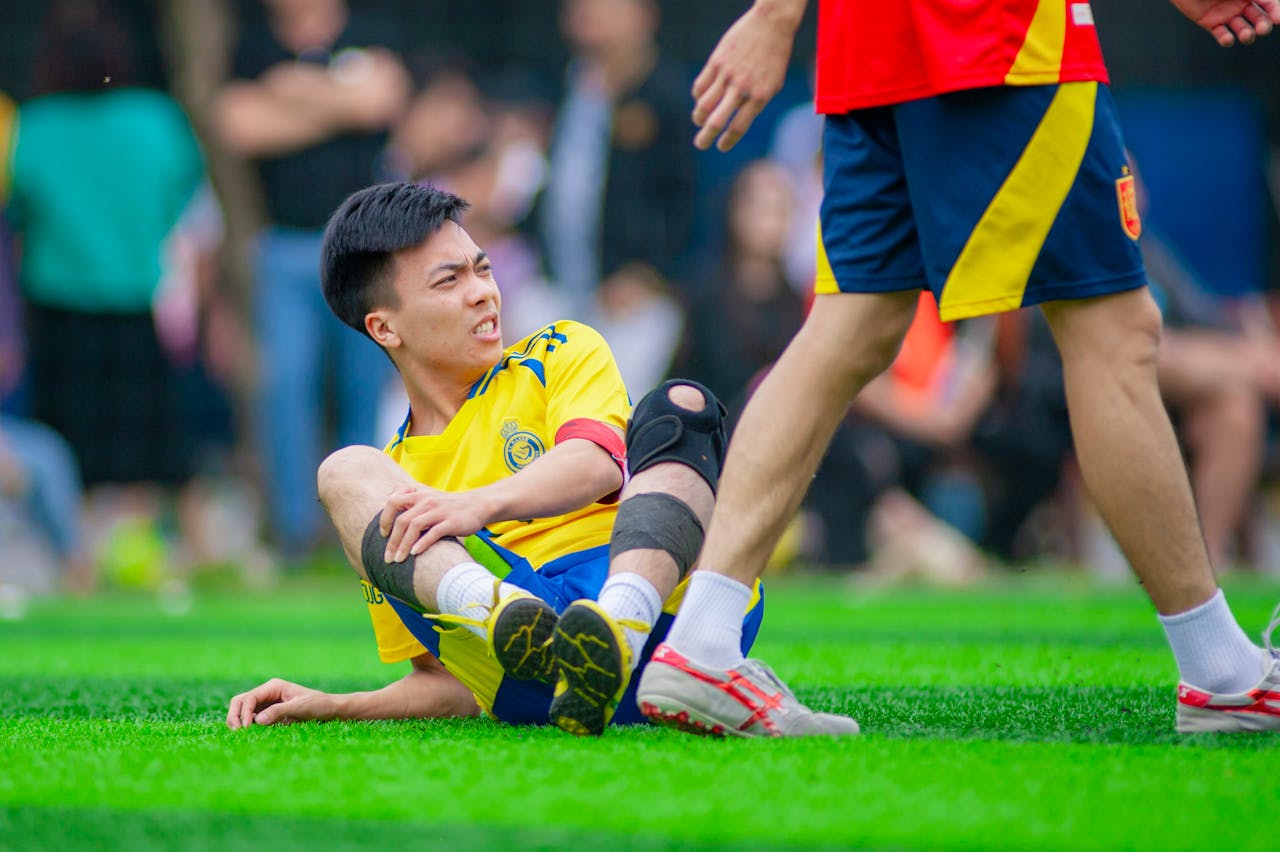Football is a high-impact sport that often leads to various injuries such as sprains, strains, and joint issues. Common injuries include ankle sprains from sudden direction changes or uneven surfaces, and hamstring strains from rapid acceleration or overextending the leg. Knee injuries like ACL tears often occur during sudden stops or twists, while MCL injuries are caused by impacts on the outer knee. Meniscus tears can happen from twisting the knee while bearing weight. Muscle injuries, including quadriceps or calf strains, typically result from overuse or sudden movements, while groin pulls are caused by overstretching or sudden sideways movements. Fractures, such as tibial and fibular fractures, can occur from high-impact collisions, and foot fractures often happen from being stepped on or kicked. Contusions, including thigh and shin bruises, are common from collisions or tackles.
Traditional treatments like rest, ice, compression, and elevation (RICE), along with physical therapy, have been standard. However, advancements in medical technology have introduced Low-Level Laser Therapy (LLLT) as an effective, non-invasive treatment option for athletes.
Understanding Low-Level Laser Therapy (LLLT)
LLLT, also known as photobiomodulation, utilizes specific wavelengths of light to penetrate tissues, promoting cellular repair, reducing inflammation, and alleviating pain. Devices such as the IASO Ultra Cold Laser and the Handy Cure Low-Level Laser are designed to deliver these therapeutic benefits directly to the affected areas.
Benefits of LLLT for Football-Related Injuries
- Accelerated Healing
LLLT stimulates cellular activity, enhancing tissue repair and reducing recovery time for common football injuries like muscle strains and ligament sprains. - Pain Reduction
By modulating nerve conduction and decreasing inflammation, LLLT provides significant pain relief, allowing athletes to resume activities sooner. - Decreased Inflammation
The anti-inflammatory effects of LLLT help reduce swelling and promote a conducive environment for healing. - Non-Invasive Treatment
LLLT offers a non-surgical, drug-free approach to managing sports injuries, minimizing the risks associated with invasive procedures and medications.
Real-Life Success Story: Mary’s Experience
Mary shared her positive experience with the Handy Cure Laser:
I have had a swollen foot for 9 years, went to many doctors and specialists with x-rays and scans performed, with no diagnosis of what caused the swelling. I decided to try the Handy Cure Laser on the top of my foot with excellent results. The swelling in my foot has improved dramatically, much to my surprise and delight.
Her experience highlights the versatility and effectiveness of laser therapy in managing various conditions, including sports-related injuries.
Research Supporting LLLT in Sports Medicine
Research, such as that highlighted in Dynamic Chiropractic, demonstrates its ability to accelerate recovery times for common sports injuries like sprains, strains, and soft tissue damage. The therapy enhances microcirculation and collagen production, crucial for faster healing and improved functional outcomes. With practical applications in devices like the IASO Ultra Cold Laser, LLLT is becoming a vital tool for athletes seeking efficient and safe recovery solutions.
Recommended Devices for Athletes
- IASO Ultra Cold Laser
Combines infrared, red, and blue light cold laser therapy with heat and vibration massage, providing a comprehensive solution for pain relief. - Handy Cure Low-Level Laser
A portable device that utilizes super pulsed infrared laser diodes and LEDs to treat inflammatory conditions, enhancing blood circulation and reducing pain.
Frequently Asked Questions
- How does LLLT work?
LLLT uses specific light wavelengths to penetrate the skin and underlying tissues, stimulating cellular processes that promote healing and reduce inflammation. - Is LLLT safe for athletes?
Yes, LLLT is a non-invasive, safe treatment modality with minimal side effects, making it suitable for athletes seeking alternative therapies. - How long does a typical LLLT session last?
Sessions usually last between 5 to 20 minutes,treatment area and the severity of the injury. - When can I expect to see results?
Many individuals experience relief after a few sessions, with significant improvements observed over a ftent treatment. - Can LLLT be combined with other treatments?
Yes, LLLT can complement other therapies such as physical therapy, enhancing overall recovery outcomes.
Low-Level Laser Therapy offers a promising, non-invasive treatment option for football players dealing with high-impact injuries. By accelerating healing, reducing pain, and decreasing inflammation, LLLT helps athletes return to the field more quickly and safely. Devices like the IASO Ultra Cold Laser and Handy Cure Low-Level Laser provide accessible solutions for those seeking effective injury management.
Explore these products and learn more about how laser therapy can enhance your recovery at Laser Pain Relief.
References:
Dynamic Chiropractic. (n.d.). Getting athletes back in the game: Low-level laser therapy for sports injuries. Retrieved January 10, 2025, from https://dynamicchiropractic.com/article/57089-getting-athletes-back-in-the-game-low-level-laser-therapy-for-sports-injuries
